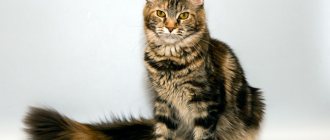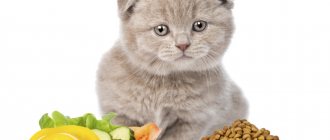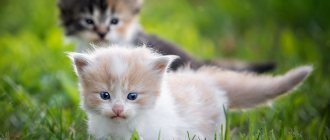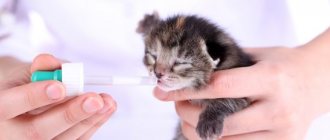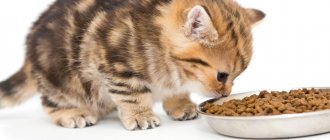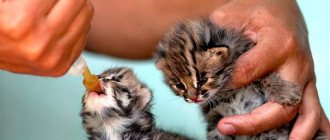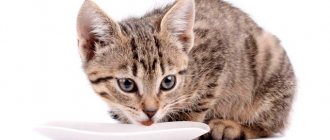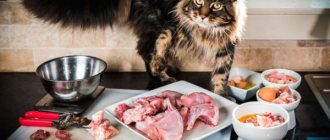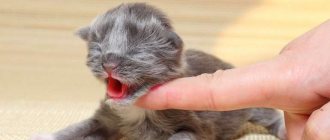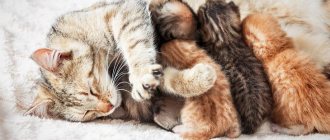Starting from three to four months of age, kittens begin to grow actively. There is a set of muscle mass, strengthening and growth of the skeletal system, and the replacement of milk teeth with permanent ones. During this same period, there is an increase in the motor activity of kittens. They begin to play and frolic a lot, which entails a lot of energy and strength.
The quality of nutrition during this period is of particular importance. Its further development and health status depend on what food the pet will receive during the period of active growth. Therefore, kittens should receive age-appropriate nutrition rich in vitamins and microelements.
Features of development of kittens at 4 months
What are the developmental features of kittens at 4 months? In addition to the constantly growing interest in the outside world, at the age of 3–4 months, the kitten enters a phase of active growth. The constant growth of bones and the process of changing teeth sharply increases the young body's need for microelements and vitamins. In addition, the kitten's activity increases, which means additional consumption of nutrients.
Advice: when the kitten’s teeth begin to change, introduce soft, boiled cartilage into its diet. The baby will learn to chew properly and relieve itchy gums at the same time.
At about 4 months, 40% of kittens develop lactose intolerance. Immediately after drinking whole milk, the baby experiences diarrhea, which goes away without intervention. The malaise is due to the fact that enzymes obtained from mother's milk die in the baby's intestines, and the milk sugar of cow's milk is not digested.
The problem can be solved by completely eliminating whole milk from the pet’s diet. Whole milk is replaced with milk substitutes and fermented milk products.
How much does a kitten weigh?
Gradual and sufficient weight gain is the main indicator of proper development. If you know the age and breed of the kitten, just weigh it on the scale.
It is advisable to weigh kittens weighing up to 1 kg on electronic kitchen scales that have a small error. To do this, use either a special container that comes with the scales, or a suitable plastic container.
Larger pets can also be weighed on household floor scales. As a last resort, you can weigh yourself, and then with your pet in your arms - and calculate the difference.
It is believed that until the age of six months, a kitten gains, on average, 100 grams of weight per week. After 6 months, the growth of a kitten of most breeds almost stops, but the weight continues to increase due to an increase in muscle mass.
However, there are breed characteristics - for example, Maine Coons grow very slowly and only by two years, or even later, gain their final weight and height. So for more accurate information, it is better to contact the breeder or a specialized website for the breed.
Here is a table showing the approximate weight parameters of kittens of different breeds by month. You can focus on it when determining the norm of development of a kitten.
Kitten weight table
| Development of kittens in the first year of life | ||||||
| Age | Weight of cats, g | Cats weight, g | ||||
| average | big | very large | average | big | very large | |
| 4 weeks | 550 | 630 | 820 | 450 | 560 | 740 |
| 6-8 weeks | 1000 | 1230 | 1500 | 900 | 1150 | 1400 |
| 10-12 weeks | 1350 | 1800 | 2300 | 1200 | 1700 | 2300 |
| 14-16 weeks | 1700 | 2700 | 3800 | 1500 | 2600 | 3600 |
| 5 months | 2050 | 3200 | 5500 | 1800 | 2900 | 4300 |
| 6 months | 2400 | 3900 | 6000 | 2100 | 3200 | 4500 |
| 7 months | 2750 | 4200 | 6500 | 2400 | 3500 | 4900 |
| 8 months | 3100 | 4500 | 6900 | 2700 | 3800 | 5200 |
| 9 months | 3450 | 5000 | 7000 | 3000 | 4100 | 5500 |
| 10 months | 3800 | 5200 | 7700 | 3200 | 4200 | 5800 |
| 11 months | 4050 | 2600 | 8000 | 3350 | 4300 | 6100 |
| 12 months | 4500 | 5700 | 9000 | 3500 | 4500 | 6800 |
| 18 months | 6000 | 9500 | 4700 | 7000 | ||
What to feed a kitten at 4 months
Kittens are offered for sale at the age of 3–4 months. Moving, separation from mother, deworming, vaccinations, changing teeth - these are just some of the reasons for serious stress. Against the backdrop of anxiety, the pet may eat poorly, lose weight, and suffer from diarrhea.
If you are wondering what to feed your kitten to make it feel better, unfortunately, you are going the wrong way. To end stress as quickly as possible, it is necessary to stabilize the factors affecting the patient as much as possible, that is, adhere to a constant diet.
If you have become a new owner and are at the first stage of creating a diet, you need to choose between:
- Natural feeding.
- Industrial feeding.
- Mixed feeding – simultaneous feeding of prepared and natural products. This type of food is not recommended by veterinarians and feed manufacturers.
Obviously, each type of feeding has its pros and cons. When caring for your pet’s health, you need to put its interests first. Let's look at food types in a little more detail.
Natural products
Natural products are considered the best choice for your pet's diet. Natural food is better digested and makes it possible to diversify the diet and adjust it according to the pet’s needs.
Natural feeding involves three options:
- Feeding raw and cooked foods in pure and mixed form.
- Feeding exclusively raw foods is a raw food diet.
- Feeding with homemade semi-finished products.
Benefits of a natural diet:
- Cheaper than feeding high-quality ready-made food.
- The ability to regulate nutritional value, vitamin content, and calorie content.
- The ability to choose a complete, hypoallergenic diet (if you have a food allergy).
Flaws:
- Food for your pet needs to be prepared separately and regularly.
- Food must be heated before serving.
- You need to take vitamin courses regularly.
If you are a supporter of natural feeding, the menu for your pet should be composed of the following products:
- Whole milk, fermented milk products, cottage cheese - in large quantities.
- Boiled and raw meat without fat and bones - beef, veal, rabbit.
- Ocean fish, low-fat - chopped, deboned, boiled or after deep freezing.
- Beef or poultry by-products, boiled, chopped.
- Chicken and quail eggs – raw, boiled, scrambled eggs (without oil). Can be mixed with vegetables or dairy products.
- Vegetables – raw, grated
The above products can be given separately (mono-diet) or mixed.
Advice! A kitten does not need additional carbohydrates if it is not lagging behind in weight gain, so using porridge as a portion filler is not recommended.
Industrial feed
In recent years, more and more owners are switching their pets to industrial food. The main advantage of finished products is that they do not need to be prepared, that is, they save time. The selection of ready-made food is based on several key factors.
Ready-made feeds are divided into types:
- Dry – granules.
- Semi-moist - pieces with gravy or jelly.
- Wet - pate or paste.
When choosing food, its quality plays a major role. The quality of feed is usually graded according to classes:
- Economy
- Premium
- Super premium.
- Holistic.
The higher quality the food, the more expensive it is. A high class of food indicates that the product is as close as possible in properties and quality to natural food.
Advantages of ready-made feed:
- High-quality feed contains all the necessary vitamins and minerals.
- High-quality feed is balanced.
- The food is stored for a long time, it can be bought for future use, which significantly saves money.
- Ready-made food is easy to dose.
Flaws:
- Ready-made food costs three to four times more than feeding natural products. Keeping your pet on cheap food (economy class) means saving on your pet’s health, which will result in even higher treatment costs.
- You cannot be sure of the quality of even the most expensive food, since they are often counterfeited.
- Ready-made food is often bought by weight, and this creates a risk of deception by the seller - the food may be mixed with “expired” food or stored incorrectly.
Kittens whose teeth have not changed should not be given dry food pellets.
Industrial menu for a kitten aged 4 months:
- Pates.
- Semi-moist food.
- Soaked dry food.
When the pet grows up, it should not be fed only dry or only wet food. To prevent diseases of the oral cavity and teeth, it is recommended that a cat’s daily portion be made up of 25% wet and 75% dry food of the same brand and line.
Ready-made feed
There are a huge number of opinions regarding which food is better - ready-made or natural. As for industrial products, the advantages here are obvious - a complete balanced diet and ease of use. The disadvantages include the presence of synthetic food additives in some feeds.
If you have chosen to feed your pet industrial food, you should consider some rules for their use.
- Do not combine dry and wet food in your diet.
- Do not change the brand of the product.
Read the manufacturer's recommendations carefully. Starting from the age of four months, the kitten can give out the entire daily portion of dry food immediately, since kittens by this time are already able to control their appetite. Wet food should be given in portions equal to a single volume and in a heated form. In order not to harm your pet’s health, it is better to choose proven and reliable manufacturers, such as: NutroChoice, RoyalCanin, Purina, Acana. The product lines of these manufacturers include both dry and wet diets. Among the most popular brands that produce food for kittens are:
- Canadian brand "Akana". The company's products belong to the super-premium category and represent a complete, balanced diet with a low level of allergenicity. Products are made from whole, fresh raw materials of plant and animal origin. Meat component - at least 70%, the rest - vegetables, seaweed, fruits, cereals, eggs. The recipe is enriched with unsaturated fatty acids, vitamins, and microelements.
- French brand Royal Canin. The optimal content of nutrients necessary for the development and growth of kittens puts the products of this brand on a par with natural nutrition. The manufacturer recommends using the food starting from the age of four months for the kitten. The company's product line also includes a series of veterinary foods recommended for consumption based on a specific disease.
Feeding regimen for a 4 month old kitten
The kitten needs to be accustomed to a feeding regime from as early an age as possible. To ensure that your child eats a balanced diet and does not overeat, you need to follow the following instructions:
- Calculate the daily feed intake based on caloric content and protein content.
- Divide the daily feed amount by the number of feedings.
It turns out that in order to correctly calculate the nutritional value of the diet, you need to know in advance how many times a day your pet should eat. Naturally, the daily food intake and number of feedings will vary depending on the size and activity of the pet.
Note! The daily food intake for a kitten aged 4 months ranges from 80–120 grams.
Typically, the daily food intake for a 4-month-old kitten is divided into:
- 4–5 full meals.
- 1-2 snacks.
As a snack, you can give the kitten an egg yolk, a piece of meat, and a little cottage cheese. A complete meal should consist of a mixture of meat or dairy products and vegetables. If you have chosen a mono-diet for your pet, he will be reluctant to consume vegetables, but they can be replaced with grass and vitamin complexes.
Natural nutrition
During the period of teeth change, the baby’s body needs solid food, mainly protein and, without fail, various dairy products. If your pet cannot tolerate whole cow's milk, you can replace it with fermented milk products. The baby’s “food basket” should contain lean meat (poultry, beef, rabbit, etc.), eggs, vegetables, and cereals. The meat part should make up more than 50% of the diet, vegetables and cereals - less than 50% of the daily portion.
It is unacceptable to feed a kitten food from your table. Human food can cause digestive problems in a baby.
A kitten definitely needs meat. Meat products can be given both boiled and raw. It should be lean meat: beef, rabbit, lamb, chicken or turkey fillet. It is better to avoid pork due to its fat content and the risk of helminth infection. Starting from the age of three months, kittens can be given raw meat, but it must first be well frozen. You don’t have to grind the products into minced meat, but simply cut them into pieces.
Dairy products are the main suppliers of calcium; during the period of active growth of the skeletal system and teeth change, their presence in the diet is of particular importance. It is better to choose low-fat products. If your baby does not digest milk well, replace it with fermented milk products (yogurt, kefir, fermented baked milk, etc.). Eggnog made from cottage cheese, milk and egg yolk is very useful for kittens. It's delicious and very nutritious. It is permissible to occasionally offer your small pet small portions of low-fat sour cream and cheese.
Vegetables are very useful, primarily as a source of vitamins and fiber, but pets do not always like the taste of them. You can get out of this situation by adding pureed vegetables (pumpkin, cabbage, carrots) to the main dish, or cooking porridge in vegetable broth.
Egg yolk can be given either boiled or raw. This is a very nutritious product, the most valuable part of a chicken egg.
Low-fat fish. It is better to choose sea fish, as it is less bony and does not carry the risk of infection with worms. But it is not recommended to offer fish too often; give it no more than once a week.
Cereals in the form of various porridges - in milk, vegetable or meat broths. The most suitable ones are semolina and rice; it is better to avoid legumes and rolled oats. Legumes are difficult to digest and cause bloating, and rolled oats are overly rich in carbohydrates.
Fresh green grass is needed to cleanse the gastrointestinal tract. You can grow it yourself or buy oat and wheat sprouts in a store or veterinary pharmacy.
Vegetable oil, which has a choleretic and mild laxative effect, can be added to the main dish in small quantities to improve the digestion process.
What to exclude from a kitten's diet?
There are a number of products whose presence in the diet of small pets is either completely unacceptable or acceptable in very limited quantities.
Unacceptable Products
- Any fatty food (meat, fish, lard, etc.).
- Bones. Meat products in a baby’s diet should be exclusively in the form of fillets. Eating bones can lead to very serious health problems.
- Whole cow's milk. It is quite fatty and often simply is not absorbed by the kittens’ body, causing intestinal upset.
- Salty, smoked, spicy foods, such as sausage.
- Canned food intended for human consumption.
- Everything is fried.
- Tomatoes and eggplants.
- Corn grits.
- Sweets.
Products allowed in limited quantities
- Hercules and legumes.
- River fish.
- Potato.
There are foods that should not be given under certain conditions. So, in case of diarrhea, it is necessary to exclude fermented milk products from the diet, and in case of constipation, solid foods rich in carbohydrates and starch.
What specific products and in what volume will be present in your little pet’s diet is up to you, but there are standard recommendations for creating a menu for a 3-4 month old kitten.
| Product name | Quantity | Frequency of use |
| Meat (beef) | 40-80 g | every day |
| Milk. Fermented milk products | 100g | every day |
| Vegetable oil | half a teaspoon | in one day |
| Chicken (minced or pieces) | 40-120g | in one day |
| Puree vegetables | 20-30g | in one day |
| Egg yolk | 1 PC | once a week |
| Cereals (porridge) | 100g | in 1 week |
| Fish (sea) | 100g | once a week |
| Liver | 50g | in 1 week |
The table shows average values. The amount of food can be changed in one direction or another by 5-10%, depending on the age of the kitten, its weight, and activity.
Water in the animal's diet
From the school course we know that a living organism consists of almost 80% water. Water plays a fundamental role in metabolism and the process of hematopoiesis. The conclusion is obvious - dehydration is deadly for small kittens.
An adult animal can fight dehydration for 2-3 days and despite extensive intoxication, the cat will survive if it receives help. When it comes to a kitten, the period is reduced to a day. Without access to water, the baby quickly loses strength, his kidneys, liver, and then his heart fail.
If you choose a commercial diet for your kitten, make sure he drinks after every meal.
Everything, even high-quality food, contains preservatives that provoke thirst. With a natural type of feeding, a kitten may be reluctant to drink because it receives a lot of moisture from food.
While the kitten is small, you should place several drinking bowls in accessible areas. A kitten may refuse to drink water because it is stale or warm. Clean drinking bowls and change the water at least once a day. In hot weather, the water needs to be changed more often. When water heats up, pathogenic bacteria quickly multiply in it, and this is a direct path to diarrhea and other problems with the gastrointestinal tract.
The right utensils for feeding
When choosing a dish for your cat to eat from, it is better to give preference to a shallow plate with wide edges. If the container is small in diameter or has high edges, this will cause discomfort while eating, as the whiskers will cling to the edges of the plate. Cats' whiskers are an organ of touch, a kind of sensor with which they navigate in space.
To optimize the feeding process, you can use automatic or electronic feeders. They have the ability to customize for a specific feeding time and portion size.
You should not blindly and unconditionally follow the rules and recommendations when creating a menu for your pet. Each of them is unique and inimitable, with its own characteristics and preferences. Careful observation of the cat, its reaction to different products or industrial feeds will allow you to choose the most suitable feeding option.
Vitamins and supplements
If you decide to feed your pet high-quality food, additional vitamins and supplements are introduced into the diet only if there is growth retardation or on the recommendation of a veterinarian. It is important to understand that an excess of vitamins is no less dangerous than their deficiency.
Advice! With a natural type of nutrition, up to the age of 1 year, vitamins are given on an ongoing basis. When the kitten is one year old, vitamins can be given in courses.
You can add natural sources of vitamins and minerals to your kitten’s food:
- Meat and bone meal.
- Fish, chicken, beef liver.
- Greens, vegetables, fruits.
- Sunflower oil, olive oil.
- Brewer's yeast.
In addition to vitamins, cats urgently need taurine. A rare amino acid is found in:
- Turkey.
- Rabbit.
- Chicken heart and liver.
- Beef heart.
- Pork, after deep freezing.
- Boiled pork liver.
- Ocean fish and shellfish.
- Raw red fish.
- Live homemade yogurt.
- Whole milk.
Pharmaceutical products are also rich sources of vitamins:
- Fish fat.
- Feed tricalcium phosphate.
- Omega-3, Omega-6.
- B vitamins.
You can buy basic vitamin complexes for cats at a pet store or veterinary pharmacy. Drugs are dosed by weight. Vitamin complexes are usually available in the form of tablets that can be crushed and added directly to food.
Industrial feed: pros and cons
Industrial animal feeds are divided into two types:
- wet food - canned food in the form of pates, pieces of meat with sauce;
- dry granulated food - small crackers.
Feeding natural food will require a lot of knowledge, patience and time. With skillful preparation of a correct and balanced menu, such nutrition will be healthier and safer.
Ready-made food has its advantages and disadvantages compared to natural food.
Industrial feed is better for several reasons:
- contains a complete balance of essential vitamins and microelements;
- easy to calculate and control the size and number of servings;
- long shelf life;
- feeding with dry food is more convenient;
- the opportunity to choose specialized veterinary food that meets the needs of a cat with health conditions.
Cats that eat only dry food must always have fresh water available.
Disadvantages of using industrial feed:
- high cost of quality feed;
- In canned food with sauce, more than half of the volume is water. Satiety with such food is reduced;
- high salt content, which threatens the development of urolithiasis;
- This food is addictive. It becomes very difficult to switch a cat to a different diet.
When feeding with ready-made store-bought food, you should pay attention to the mark indicating whether any type of food is complete. It can only serve as an additive to the main diet and does not satisfy all the nutritional needs of the cat.
When combining dry food with canned food, it is better to stick to the proportion - about 70% dry food and 30% canned food.
Some artificially bred cat breeds are susceptible to allergies and metabolic disorders. To maintain health, it is recommended to feed them only with fully balanced ready-made special food.
What should you not feed a kitten at 4 months old?
It is important to know what you should not feed a kitten at 4 months:
- Bones, pure fat, skin, especially poultry.
- Palm oil.
- Grapes, raisins.
- Juicy and sweet fruits.
- Soy.
- Mushrooms.
- Corn and semolina.
- Raw freshwater fish.
- Dry, salted fish.
- Products containing sugar or sugar substitutes.
- Products containing xylitol (chewing gum, some sweets).
- Products containing flour or yeast.
- Products containing caffeine, cocoa, any stimulants (sweets, tea, coffee, chocolate).
- Products containing marinades, salt, spices.
- Smoked products, including sausages, balyki, fish.
- Expired products.
- Leftovers from the table.
You need to be careful with controversial products:
- Fresh pork is a source of helminths and false rabies.
- Raw ocean fish are a source of helminths.
- Whole milk – risk of individual intolerance.
- Chicken eggs are an allergen.
- Factory-bred chicken – risk of allergies and individual intolerances.
- Raw and boiled chicken liver in large quantities.
- Cereals.
Advice! Products that can become sources of helminths should be boiled or pre-frozen. Allergenic foods are introduced into the diet carefully, monitoring the body's reaction. Cereals are necessary only if there is a clear lack of carbohydrates - stunted growth, low activity.
What not to give to kittens
The diet should not include hazardous or undesirable foods. You should absolutely not give your kitten the following foods:
- Fresh meat. May cause helminthiasis.
- Pork. Leads to the development of liver cirrhosis, pancreatitis, and chronic renal failure. May cause unwanted reactions (gastrointestinal upset, allergies).
- Smoked, spicy, fatty foods. Causes inflammatory diseases of the gastrointestinal tract, dysbacteriosis.
- Sausages, any food from the table. Contains spices and salt that are harmful to the kitten.
- Onion garlic. Poisonous in any form.
- Sweets. The most dangerous is chocolate, which is a powerful poison.
- Bones. They damage the esophagus and can cause internal bleeding.
- Economy class dry food. Lead to the development of various diseases, including urolithiasis.
Some foods can cause negative consequences, so such foods are given with caution or completely excluded from the diet. These include:
- Fish. Too much content in the diet provokes the development of urolithiasis. This product is contraindicated for kittens under one month of age. River fish should not be given, as it causes helminth infection.
- Liver of animals and birds. Too frequent consumption can cause hypervitaminosis of vitamins A and D.
- Milk, flour products, potatoes, legumes. Causes gastrointestinal upset.
